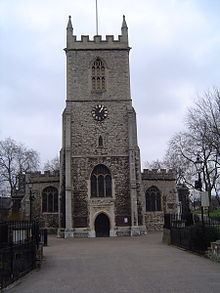Deanery Tower Hamlets | Heritage designation Grade I | |
 | ||
Churchmanship Modern Inclusive Anglo Catholic Burials Thomas Spert, Richard Pace, John Cass, John Leake Similar St George in the East, All Saints Church - Poplar, St Paul's Church - Shadwell, St Anne's Limehouse, St Matthew's - Bethnal G | ||
St Dunstan's, Stepney is an Anglican Church which stands on a site that has been used for Christian worship for over a thousand years. It is located in Stepney High Street, in Stepney, London Borough of Tower Hamlets.
Contents
History
In about AD 952 the Bishop of London — who is also Lord of the Manor of Stepney — replaced the existing wooden structure with a stone church dedicated to All the Saints. In 1029, when Dunstan was canonised, the church was rededicated to St Dunstan and All Saints, a dedication it has retained.
Up until the early fourteenth century the church served the whole of Middlesex east of the City of London. Then new churches were built at Whitechapel and Bow. The existing building is the third on the site and was built of Kentish ragstone mainly in the fifteenth century (although the chancel dates from 200 years earlier). A porch and octagonal parish room were added in 1872.
The church was restored extensively in 1899, at a cost of £5,600. The vestries and some of the main building were destroyed by fire on 12 October 1901, including the organ which had carvings by Grinling Gibbons. The restoration cost £7,084, and the church was re-opened in June 1902 by the Bishop of Stepney.
Bells
The ring of ten bells, the heaviest weighing 28¾ hundredweight, which hang in the belfry, were cast at the local Whitechapel Bell Foundry and are tuned to C#. The seven oldest bells were cast by Thomas Mears and Son, Whitechapel, in 1806. The bells were re-hung in 1899. Three were recast in 1952 when repairs were made to the tower. The bells are mentioned in the nursery rhyme Oranges and Lemons: "When will that be, say the bells of Stepney."
Monuments
Buried here is Lord Darnley, the elder brother of the husband of Mary Queen of Scots. He died aged 12. His resting place is marked with a 12 feet (3.7 m) slab of Purbeck marble.
Churchyard
The church is surrounded by a churchyard of nearly seven acres (28,000 m²). In 1658 William Greenhill was appointed vicar whilst retaining his position as a preacher at Stepney Meeting House. He held this post for about seven years, till he was ejected immediately after the Restoration in 1660.
Shortly after this, the churchyard was enlarged to cope with the massive number of deaths during the Great Plague of London. In one eighteen-month period 6,583 died, with 154 being buried in one day in September 1665.
The church has a long, traditional link with the sea and many sailors were buried here. It was once known as the 'Church of the High Seas'. The graveyard is also where Roger Crab, the 17th-century hermit who lived on a diet solely of herbs, roots, leaves, grass and water, is buried.
Current activities
The church continues to be open to visitors and worshippers from all over the world. There is an active congregation who help to continue the life of the church community. As well as the Arbour Centre (a St Dunstan's community project), there is a close connection with two schools: Stepney Greencoat Church of England Primary School and Sir John Cass and Redcoat Church of England Secondary School. St Dunstan's also employs a Children and Community Worker funded by the Bishop of London's Mission Fund.
